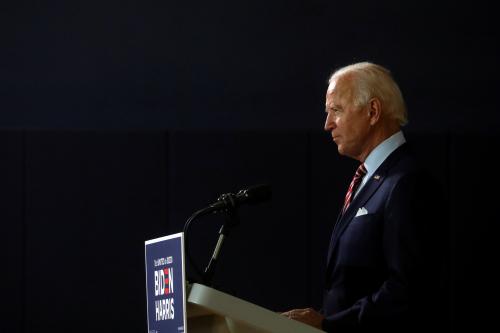Introduction
As of September 2020, approximately 43 million Americans held federal student debt. Even before the pandemic, struggling borrowers reported that financial insecurity was a major barrier to repayment. And over the last year, COVID-19 has exacerbated these challenges for many, including those in low-income communities and communities of color.
To address the pandemic and related economic downturn, Congress and the Trump administration suspended payments, interest, and collection efforts for borrowers with student loans held by the Department of Education. The Biden administration extended those protections through at least September 30, 2021 and expanded them to include borrowers with commercially held Federal Family Education Loan (FFEL) Program loans that are in default.1 However, for many, this insecurity—reflecting long-standing structural inequities and racism in health care, education, and wealth-building opportunities—will be long term. And those enrolled in or considering postsecondary education, particularly low-income students and students of color, may postpone graduation, delay enrollment, or experience other forms of hardship, increasing their odds of leaving school without a degree and eventually defaulting on their loans.
Compounding these challenges, the current student loan repayment system is complex, confusing to borrowers, and unprepared for tens of millions to reenter repayment simultaneously after the period of paused payments ends. To address these challenges and deficiencies, a host of advocates, researchers, and policymakers from across the political spectrum have called for large-scale student loan-related reforms. Proposals include making existing forgiveness programs—such as borrower defense to repayment, the Public Service Loan Forgiveness (PSLF) program, closed-school discharge, and total and permanent disability discharges—work better for borrowers;2cancelling some or all student debt; fixing the income-driven repayment system; and further extending the current payment pause, among others.
This essay explores three additional opportunities for the Biden administration to address the challenges facing families, students, and current and future borrowers:
- Helping millions of borrowers exit and no longer experience the severe financial consequences of default;
- Ensuring borrowers can more easily access affordable payments and forgiveness on their loans; and
- Raising the federal poverty thresholds to ensure safety net programs reach more financially insecure households.
This analysis identifies existing authorities and examines benefits of and key considerations for each reform. It is not meant to be exhaustive or a guide for implementation; these federal programs are complex, are intertwined with others, and affect families’ financial security in myriad ways. Moreover, neither a single policy nor authority alone can fix the problems endemic to a trillion-dollar loan program. These ideas are part of what must be a suite of policies designed to ensure those who have been most likely to struggle historically and those at risk for delinquency, default, and growing balances moving forward are protected, now and in the future.
Wipe the slate clean for borrowers in default
As of September 2020, close to one in five borrowers with federally managed student debt was in default. In the year before the pandemic, more than one million Direct Loan borrowers defaulted. Recent research indicates that borrowers of color, those with low incomes, those who don’t complete a degree, student parents, and first-generation students, among others, have particularly high rates of default. At the same time, these groups are more likely to have struggled during the pandemic.
Providing defaulted borrowers with a quick, manageable pathway to bring their loans back into good standing during the pandemic would ensure that millions of families no longer experience the severe consequences of default—including collection fees, wage garnishment, withholding of federal benefits and tax refunds, and credit score damage—which are often felt more acutely by vulnerable communities. It would also lay the foundation for large-scale reforms to the student loan repayment system.
Borrowers can typically exit default or return their loans to good standing through:
- Voluntary payments or involuntary collection efforts, including wage garnishment and the withholding of federal benefits, to repay their outstanding loans.
- Making nine payments within a 10-month window as part of a rehabilitation agreement. Payments can be as low as $5 per month. Borrowers can typically rehabilitate a loan only once, and when loans are rehabilitated, the default is resolved on a borrower’s credit report (although delinquencies—periods of missed payment leading up to a default—remain).
- Consolidating their existing loans into a new loan—which is considered non-defaulted—by entering an income-driven repayment plan or making three on-time payments on the loan. Like rehabilitation, borrowers can typically consolidate once.3 However, post-consolidation, the default is not removed from a borrower’s credit history. Because borrowers technically have a new loan once they consolidate, they lose any previous months of qualifying payments toward forgiveness in an income-driven plan including those that could apply toward PSLF and may lose access to other important rights and benefits. Still, consolidation can provide access to more generous income-driven plans, PSLF, and other loan discharge options for those with FFEL Program loans.4
- In some cases, including school closure or fraud, the Department can discharge a borrower’s loans.
Using the HEROES Act of 2003 to help borrowers exit default
The Higher Education Relief Opportunities for Students Act (HEROES Act) of 2003,5 gives the Secretary of the Department of Education authority to waive or modify any “statutory or regulatory provision applicable to the student financial assistance programs under title IV of the [Higher Education] Act as the Secretary deems necessary in connection with a war or other military operation or national emergency,” such as the one the president declared last year at the start of the pandemic, still in effect as of the publication of this analysis. These student financial assistance programs include student loans.
The Department used HEROES Act authority to extend the current period of paused payments, interest, and collections, as outlined in the 2020 Coronavirus Aid, Relief, and Economic Security Act (CARES Act), beyond the CARES Act’s payment pause expiration of September 30, 2020. (While the announcement of the extensions was made in August 2020, the authority used to do so was not specified until a December 2020 notice in the Federal Register.6) As mentioned above, these pauses have been extended through at least September 2021, and in addition to loans held by the Department of Education, they now apply to commercially held, defaulted FFEL Program loans.
HEROES Act waivers and modifications may be used to assist “affected individuals,” which include those who are serving in the military or National Guard during an emergency, reside or work in a disaster area, or are experiencing direct economic hardship as a result of the emergency. In the Federal Register, the Department noted that it considered an “affected borrower” to be “one whose Federal student loans provided under title IV are in repayment,” broadly interpreting its HEROES Act authority to be applicable to more than 36 million people.7
Importantly, in addition to pausing student loan payments, interest, and collections, the CARES Act and HEROES Act waivers directed the Department of Education to count each month of suspended payments as a qualifying payment for loan forgiveness—such as for those enrolled in an income-driven repayment plan or eligible for PSLF—and for rehabilitation agreements. As a result, those who were in the process of rehabilitating their loans immediately before the pandemic began, and those who entered the process early in the pandemic, have completed their 9-10-month rehabilitation period and exited default without having to make additional (or any) payments.
HEROES Act authority could be used to allow additional borrowers to exit default during the pandemic emergency through rehabilitation by waiving or modifying several regulatory and statutory provisions. These should include clarifying that the requirement that borrowers make nine on-time, voluntary payments within a 10-month window be applied retroactively to the beginning of the national emergency in March 2020, waiving the prohibition on using rehabilitation to exit default more than once (both to allow those who have already used it to do so again and ensure those who have not used it but may need to do so in the future maintain access), and ensuring that exiting default does not count as an interest capitalizing event.8
The ability to exit default during the pandemic using the HEROES Act could be fee-free. For some borrowers going through rehabilitation (those assigned to a private collection agency, or PCA), a percentage of each of their nine rehabilitation payments is typically charged as a collection fee. Given that borrowers whose payments are paused have been able to rehabilitate their loans without making payments, those fees are likely effectively being waived by the Department. And the Department has previously reported that no further collection fees are charged for many who rehabilitate their loans.
HEROES Act authority could also be used to allow borrowers to exit default via consolidation by waiving several program requirements similar to those mentioned above. Borrowers would also have to sign new Master Promissory Notes for their new loans and additional consolidation-related requirements would need to be waived or modified. Otherwise, borrowers who consolidate would face penalties that those using rehabilitation would not. For example, the default would remain on a borrower’s credit history and any previous payments made toward forgiveness would be erased. In addition, those exiting default via consolidation with the assistance of a PCA could have fees added to the balance of their new loan. As noted above, consolidation would provide additional benefits for many borrowers.
Considerations for ensuring post-default success
The Department may want to automatically transfer borrowers out of default by waiving the requirement that borrowers proactively enter into a rehabilitation agreement (with the option to opt out) or it may want to require borrowers to accept the terms of the rehabilitation. Historically, rates of re-default have been high. In one study, more that 40 percent of borrowers who exited default through rehabilitation or consolidation defaulted again within five years. This means that if borrowers miss payments once they reenter repayment, they can further damage their credit scores. And without additional reforms, borrowers would be re-entering a repayment system that did not serve them well the first time around.
However, those who are able to access an income-driven plan after defaulting have much higher rates of long-term success. While some borrowers consolidate out of default by choosing to enter an income-driven repayment plan, it would be difficult for the Department to enroll those who do not into an income-driven plan without receiving additional information about their incomes and family sizes. But the HEROES Act could reduce barriers and provide easier access to such plans for all borrowers, and particularly for those exiting default, such as through temporarily allowing self-certification of income and family size.9 Entry into an income-driven plan at the end of a rehabilitation or consolidation period would also ensure that the current months of paused payments are counting toward forgiveness.
While this would provide assistance for many with student loans, it is not a substitute for major reforms to the income-driven repayment program. Reforms are needed as long as the current system requires some to take out debt to fund a postsecondary education. Outside the scope of this essay, a host of researchers, policymakers, and advocates are working toward changes in how income-driven plans are designed and how they are administered. These include lowering payments for struggling borrowers, addressing interest accrual and growing balances, reducing the length of time borrowers carry debt, removing administrative hurdles to enrollment and reenrollment, improving oversight of programs and contractors, and ensuring existing forgiveness programs work better for borrowers.
In addition, allowing borrowers to exit default would ensure they have access to tools and protections offered by the repayment system as stakeholders advocate for larger reforms. Policy analysts and advocates have identified and promoted the creation of a simpler pathway out of default, creating consistent terms for all borrowers who exit, forgiving debt for those who have been in default for an extended period of time, limiting collections, and eliminating the default system by allowing existing loan servicers to manage defaulted loans.
Different rules via statutes, regulations, and various other procedures apply to Direct Loans vs. FFEL Program loans and federal loans held by the Department vs. those that are held by commercial entities. Thus, the specifics of each program—and the roles, responsibilities, and funding of other lenders and Guaranty Agencies—would need to be considered to ensure that the HEROES-related waivers and modifications could apply in the same ways to all borrowers. In addition to the administrative actions mentioned in this analysis, several pieces of legislation have been introduced to provide borrowers with commercially-held FFEL Program loans with similar protections to those currently provided to borrowers with debt held by the Department of Education.
These actions would have significant financial implications for the Department and its contractors. Removing borrowers from default would mean that more than 8.5 million people10 would need to have their loans assigned to a student loan servicer. In addition to paying servicers to manage these loans, the Department must ensure that they have appropriate oversight, standards, and resources—staffing, financial, or otherwise—to prevent these previously-struggling borrowers from re-defaulting once the current payment pauses end (and at the same time that tens of millions of others will also be reentering repayment and needing assistance).
Removing borrowers from default could save money—for example, before the pandemic, PCAs were paid a fixed fee of $1,741 for each completed rehabilitation while servicers were paid, at most, $25 to service a loan for a similar 9-month period.11 However, the funding for PCA contracts is mandatory while the money used to pay for servicing is discretionary, appropriated annually by Congress. This means that money saved on one side of the system would not necessarily be used to pay for increased expenses on the other side.12
There are also potentially longer-term implications for the Department’s new Business Process Operations contractors. While these entities are not currently actively managing loans,13 their contracts include recovery and collection activities, which may need to be supplemented or adjusted based on future system reforms.14
Ensure borrowers can more easily access affordable payments and forgiveness on their loans
Ensuring that the student loan repayment system is easy to use and borrower-friendly is an important piece of any package of reforms. If implemented effectively, the 2019 Fostering Undergraduate Talent by Unlocking Resources for Education Act (FUTURE Act) has the potential to streamline repayment for millions of current and future borrowers.
Implementing the FUTURE Act to facilitate access to income-driven plans
The FUTURE Act facilitates the secure sharing of relevant data between the Internal Revenue Service (IRS) and the Department of Education.15 This data-sharing is intended to streamline three processes: the process for filling out the Free Application for Federal Student Aid (FAFSA), the three-year process for monitoring earnings post-discharge for totally and permanently disabled borrowers, and the application and annual recertification processes for income-driven repayment plans.16
Currently, in order to apply or recertify for an income-driven repayment plan, a borrower needs to submit income and family size information to the Department of Education. This creates a duplicative process for those whose tax data are already on file with the IRS. Research indicates that the information-sharing process can create a barrier to enrollment for borrowers. While some borrowers could use the IRS Data Retrieval Tool to transfer tax information directly into their applications, the FUTURE Act would make this transfer automatic (for those who consent to have their data shared), reducing obstacles to accessing affordable payments. In addition, it would also verify that no taxes were filed.
The Act has no required implementation date. The Department of Education’s Office of Federal Student Aid has signaled that full implementation will not occur until FY23-24. As part of the required coordination, the IRS must share relevant borrower data with the Department of Education “only for the purpose of (and to the extent necessary in) determining eligibility for, or repayment obligations under, income-contingent or income-based repayment plans.” While the law requires these data to be used to determine eligibility and calculate payments, it does not require that the sharing of these data mandate enrollment into such plans. Instead, the law requires that the Department of Education “establish and implement…procedures” to use this tax information to “determine repayment obligation of the borrower without further action by the borrower.” These provisions apply to a borrower who “selects, or is required to repay such loan pursuant to, an income-contingent repayment plan; or recertifies income or family size under such plan.”
Thus, the Department could choose to separate consent for data-sharing and enrollment into an income-driven plan. It should allow borrowers to opt into data-sharing early (and often) in a borrower’s interactions with the Department. For example, for new borrowers, options for consent could be embedded in the FAFSA, the Master Promissory Note, or the new Annual Student Loan Acknowledgement process.17 For existing borrowers, the Department could collect consent in multiple ways, including allowing borrowers to opt in by making a selection via their online accounts and when they enroll in or recertify for income-driven plans.
Early consent for data sharing would allow the Department and servicers to inform borrowers not enrolled in an income-driven plan what their payments would be if they were to enroll. This would be particularly meaningful for those eligible to make $0 payments. Separating consent from enrollment should not limit discussion about how to treat enrollment. For example, upon granting consent, borrowers could opt into being automatically enrolled in an income-driven plan when they enter repayment or if they miss multiple payments or become severely delinquent.
Considerations for those with changing circumstances
Automatic sharing of tax information will remove barriers to enrollment in an income-driven plan. It is still important to ensure that there is an easy way for borrowers to update their income information in between tax cycles if their circumstances change. Currently, those who provide alternative documentation of their income in order to apply for, recertify for, or modify payments while in an income-driven plan are required to demonstrate the components of their own (and a spouse’s, if appropriate) adjusted gross income. While there isn’t a defined, comprehensive list of acceptable documentation, the application for enrollment in such a plan indicates that borrowers can include evidence of “taxable…income from employment, unemployment income, dividend income, interest income, tips, and alimony” that is no more than 90 days old. However, borrowers are advised to not provide evidence of untaxed income, such as what might be received as part of a public assistance program.
While documentation of untaxed income is excluded, such documentation—including evidence of receipt of public assistance or benefits as part of a means-tested program—could be proof, in some cases, that a borrower has taxable income which is below a certain threshold and that a borrower qualifies for a lower or $0 income-driven monthly payment. To make the submission of alternative documentation of income easier for many vulnerable borrowers, especially those who might not have a regular or consistent paycheck, the Department could direct servicers to accept evidence of enrollment in some public assistance programs as proof of having taxable income below a certain threshold and provide guidance on how to interpret such documentation.18
Raising the federal poverty thresholds to ensure safety net programs reach more financially insecure households
Advocates and policymakers have long highlighted the fact that the federal poverty thresholds—based on family food budgets from more than half a century ago—are far too low and not representative of today’s families’ needs. The Biden administration could change the way these metrics are calculated through a federal regulatory process that amends or replaces an Office of Management and Budget (OMB) policy directive. This would not only expand and strengthen the social safety net but also ensure that more low-income borrowers are eligible to make low or $0 payments on their loans when enrolled in income-driven plans.
OMB statistical policy directives and the federal poverty thresholds
The Census Bureau issues annual federal poverty thresholds—following the Office of Management and Budget’s (OMB) Statistical Policy Directive 14—which are used to calculate official poverty population statistics. As required under law, each year, the U.S. Department of Health and Human Services (HHS) issues federal poverty guidelines, which are simplified versions of these thresholds used administratively to determine eligibility and calculate benefits for a host of means-tested programs, including Head Start, the Supplemental Nutrition Assistance Program (SNAP, formerly Food Stamps), and parts of Medicaid, among others. In addition, some charities, companies, and state and local governments use the HHS guidelines to set eligibility for services that they provide. In 2021, the guideline is $12,880 for a single individual and $26,500 for a family of four.19
There is precedent for taking administrative action to alter the poverty thresholds, which could be narrow or broad in scope. For example, until the early 1980s, there were separate poverty thresholds for farm and non-farm households. Technical changes to eliminate this difference (and several others) were proposed and approved by government committees and the then-Cabinet Council on Economic Affairs in 1981. And in 2019, the Trump administration explored making regulatory changes to the way the poverty thresholds are calculated, albeit in a way that would have decreased the number of families eligible for benefits over time. (While some argued that the limited scope of the exploration made it unlawful, a fully considered effort to reflect the true needs of American households should be encouraged.)
The intersection of poverty policy and student loans
In addition to the safety net programs listed above, formulas to calculate borrowers’ payments as part of income-driven repayment plans are also tied to the federal poverty guidelines (and thus, to the federal poverty thresholds) by statute20 or regulation,21 depending on the plan. For example, borrowers’ monthly payments are calculated as a percentage of their “discretionary incomes,” adjusted gross income minus 150% of the poverty guidelines for their family size and state. Borrowers must provide income and family size data to the Department annually to recertify for such plans. In addition to ensuring that more families are eligible for a host of social safety net programs and benefits,22 raising the poverty thresholds could ensure that millions more borrowers are eligible for low or $0 payments as part of an income-driven repayment plan.
Considerations for designing new poverty metrics
Establishing a formula for meaningfully raising the poverty thresholds will be no small task. It will require the consideration of families’ current and changing needs, the management of changes to individual programs, and the anticipation of consequences that may occur at the intersection of programs. But it would help families recover from a pandemic that has devastated many—especially communities of color—by expanding access to numerous benefits, including Head Start, SNAP, Medicaid, and others, as mentioned above. This would strengthen the social safety net, particularly for millions of low-income and -resource households. Raising the poverty thresholds also sends an important signal that the current poverty level does not represent a livable wage. And many benefits programs, especially those that target or provide spillover effects for children, have a return on investment.
This is not a new idea. Many thoughtful analysts and researchers have been working to revise the poverty measures for decades. Others have proposed changing he underlying methodology for how individual benefits are calculated, which the government is in the process of reviewing. Policymakers should keep several things in mind when designing a new measure.
First, perceived political risks may dissuade action. Any president who raises—through a change in formula, methodology, or otherwise—the poverty thresholds could seem responsible, on paper, for raising the percentage of people in poverty in America. For example, in 2011, the Census Bureau debuted the Supplemental Poverty Measure (SPM), which, while not perfect, provides an alternative to the official poverty measure by taking into account where families live and work and medical expenses, among many additional factors. The SPM poverty rates are typically higher (in most population groups) than the official measures. But the act of increasing the poverty rate on paper is a critical step to decreasing poverty in real life. It would also provide an opportunity to demonstrate additional, positive policy effects for those who may need assistance but were not previously receiving it.
Second, this is an expensive and technically complex proposition. Expanding eligibility for entitlement programs would involve additional spending each year. For programs that are not open-ended, the government would have to spend more to include additional families at the same level of service or find cost savings in the existing programs.23 This change also comes with the risk that policymakers could make responding eligibility cuts or otherwise restrict access to means-tested programs.
In addition, raising the poverty thresholds could have consequences that should be considered and, where possible, eliminated. When this proves difficult, policymakers may wish to consider whether other measures of need could be used to expand eligibility for benefits. For example, current immigration rules state that a noncitizen may be ineligible for admission to the United States or to adjust their status if they are or are likely to be a ‘‘public charge,’’ defined as a person who depends on the government for his or her income. In addition, those sponsoring a noncitizen must demonstrate that they are able to support the individual at an annual income of at least 125 percent of poverty. Raising the poverty thresholds without corresponding adjustments in immigration policy could make it harder for sponsors to demonstrate support and for noncitizens to progress through the immigration system toward legal permanent resident or citizenship status.
In addition, expanding Medicaid benefits through higher poverty thresholds could make some families worse off. For example, changing the poverty thresholds could shift—without any changes in a family’s income—who falls into the Medicaid coverage gap. In states that have not expanded Medicaid eligibility as part of the Affordable Care Act (ACA), these households have incomes below the poverty guidelines but above their state’s Medicaid eligibility level. (On the other hand, these changes could also provide benefits for much higher-income households by shifting who is eligible for the ACA premium tax credits and cost-sharing subsidies, which help reduce the cost of insurance and medical care for those between 100-400% and 100-250% of the poverty level, respectively.24)
Conclusion
Researchers, policymakers, analysts, and advocates have documented problems in the student loan repayment system that require comprehensive solutions. This essay highlights three proposals that should be considered by the Biden administration as part of a larger package of reforms: providing borrowers with a pathway out of default, ensuring they can access affordable payments and forgiveness, and expanding access to safety net programs. The pandemic has presented and exacerbated unprecedented challenges for millions of borrowers. But it also presents opportunities, including both a moment when most borrowers with federal loans are not required to make payments and additional tools that the new administration can use to tackle student debt from multiple angles.
The author did not receive financial support from any firm or person for this article or from any firm or person with a financial or political interest in this article. They are currently not an officer, director, or board member of any organization with an interest in this article.
-
Footnotes
- Those with commercially held FFEL Program loans that are not in default, among others, are not included in these protections.
- In March of 2021, the Department of Education announced that borrowers with total and permanent disabilities who are in the post-discharge monitoring period will not have to submit income information during the pandemic emergency and those who have their loans reinstated during this period will regain their discharges. The Department also announced changes to the borrower defense to repayment process to ensure borrowers with approved claims receive a full discharge of their loans. Many have pointed to these changes as an important first step but indicated that more should be done to assist struggling borrowers.
- Borrowers may be able to reconsolidate if they take out additional loans.
- Consolidation can also provide access to the pandemic-related protections for those with commercially held FFEL Program loans that are not in default.
- The HEROES Act was made permanent in 2007.
- In addition, the Department of Education’s office of Federal Student Aid indicated in its FY2020 Annual Report that the relief provided to borrowers from March 13-26, 2020 (after the national emergency was declared but before the CARES Act was signed into law on March 27, 2020) was executed via the HEROES Act.
- This number includes borrowers with federally managed loans in the grace period, repayment, deferment, forbearance, and default as of September 2020 in addition to the 1.14 million borrowers with commercially held FFEL Program loans in default. Some of these borrowers may also have other types of loans.
- When borrowers exit default, existing interest can be added to their principal and begin accruing interest.
- Self-certification is already permitted for those with no taxable income. The Government Accountability Office has recommended that the Department do more to verify borrowers’ income and family size information. Swift implementation of the FUTURE Act would automate this process moving forward (as described later in this analysis) while reducing errors or improper payments. Given the urgency of the COVID-19 pandemic, further short-term flexibilities may be especially warranted.
- This number includes borrowers with federally managed loans in default as of September 2020 in addition to the 1.14 million borrowers with commercially held FFEL Program loans in default. Some of these borrowers may also have other types of loans.
- Before the pandemic, servicers were paid $2.85 per month for borrowers who were current on their payments.
- If borrowers are removed from default, when the current payment pauses end the Department will not be bringing in money from collections efforts. But some borrowers who were previously in default may make non-$0 payments.
- Several of these contractors currently manage loans in their role as federal loan servicers.
- The current Business Process Operations contracts specify payments of approximately $32-$38 for loan rehabilitations.
- The FUTURE Act also provided permanent funding for Historically Black Colleges and Universities and other Minority Serving Institutions.
- The CARES Act made technical changes to the Internal Revenue Code, which affect the implementation of the FUTURE Act, and the Consolidated Appropriations Act of 2021 also simplified the FAFSA.
- Due to the pandemic, implementation of the Annual Student Loan Acknowledgment has been delayed.
- In general, dependent students qualify for a zero expected family contribution for the purposes of calculating eligibility for financial aid if their parents’ income is below a certain threshold and someone in their household qualified for Medicaid, Supplemental Security Income (SSI), Supplemental Nutrition Assistance Program (SNAP, formerly Food Stamps), Free and Reduced-Price School Lunch, Temporary Assistance for Needy Families (TANF), or Special Supplemental Nutrition Program for Women, Infants and Children (WIC). Where appropriate, similar criteria could be used for submission of alternative documentation of income for enrollment or recertification in an income-driven repayment plan.
- These values are for the 48 contiguous states and the District of Columbia. The figures are higher for Alaska and Hawaii.
- In the Higher Education Act, income-based repayment plans are tied to 150% of the federal poverty guidelines.
- Income-contingent repayment plans, including Pay As You Earn (PAYE) and Revised Pay As You Earn (REPAYE), are tied via regulation to 150% of the federal poverty guidelines.
- A recent paper estimates that currently, approximately 12 percent of families living in poverty have student debt.
- In some cases, additional spending would also be required at the state level.
- Among other changes, the American Rescue Plan Act of 2021 expanded and increased premium tax credits for two years.
The Brookings Institution is committed to quality, independence, and impact.
We are supported by a diverse array of funders. In line with our values and policies, each Brookings publication represents the sole views of its author(s).







